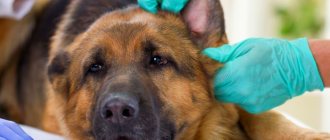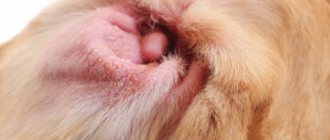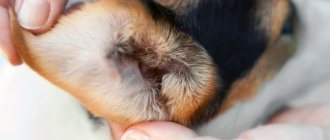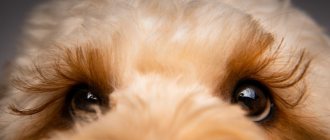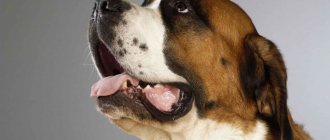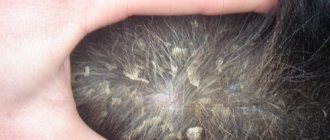When dogs develop sores on their ears, owners who imagine themselves to be experts use potent drugs and cause irreparable harm to their pets. If you use a universal antibiotic, pathogenic fungi are activated. Uncontrolled use of antimycotics increases the proliferation of pathogenic cocci. In addition, medications can provoke allergic reactions.
I have compiled an overview of the causes of ear sores. I have selected medications that you can use yourself. Determined in what cases to seek veterinary help.
If you have established a preliminary diagnosis, go to the “Treatment” section. The sequence of your actions is described step by step there.
Causes of ear diseases in dogs
- Allergy.
- Parasites (ticks, fleas).
- Infections, inflammations.
- Trauma, foreign body.
- Hormonal imbalances.
- Oncology.
- Heredity.
You need to understand that ear diseases in dogs occur more often than we would like. It is important to monitor the condition of your pet's ears every day. Because he can “pick up” an infection after every walk, consumption of some new product (food allergy) or contact with other animals. The manifestation of the disease can be caused by stress, as well as insufficient care of the auricle. The breeds most prone to ear problems are those with long, floppy ears (due to insufficient ventilation).
This is not a reason to crop your ears! Cupping leads to other serious consequences.
Vasculitis
Vasculitis is an inflammation of blood vessels caused by a disorder of the animal's immune system. The body begins to attack itself, because of this, small vessels are destroyed and bruises and wounds appear on the skin, quickly healing with brown crusts.
The first organ to show signs of the disease is almost always the ears, since the small blood vessels in them run very close to the surface. This problem can affect any dog, regardless of age or gender. Veterinarians have not identified any statistics indicating that young animals get sick more often than older ones.
Symptoms of vasculitis:
- Small wounds on the tips of the ear, covered with crusts.
- Redness of the affected areas.
- Hair loss in areas of redness and vascular damage.
- Gradual swelling of the development focus.
- The appetite decreases sharply, causing the dog to rapidly lose weight.
- Severe pain.
- Periodic febrile seizures that go away on their own after a short time.
Vasculitis itself never occurs; in essence, it is rather the body’s reaction to a more serious problem.
The development of vascular inflammation can be provoked by:
- Some types of infections.
- Development of autoimmune diseases.
- Reaction to the administration of certain medications. Quite often it occurs either after vaccination with a new vaccine that has not yet been tested by this dog, or after using self-prescribed medications.
A huge problem for owners is an accurate diagnosis, since when contacting a veterinarian with such symptoms, the possibility of infection by parasites is first checked, and only after that research begins to help establish the true cause of what is happening:
- Analysis of urine.
- Complete blood test.
- Biochemistry of blood.
- X-ray or ultrasound examination of internal organs is carried out immediately after confirmation of suspicion of vasculitis, as this is the only way to determine the degree of neglect of the process and the damage caused to it.
Vasculitis is only a symptom of another, more dangerous disease, so you can get rid of it only after identifying the root cause and curing it.
At the same time, it is almost impossible to cure a dog at home on your own, since complex therapy using a number of drugs is required.
Types of ear diseases and their symptoms
Allergic and infectious otitis
Otitis is an inflammation of the middle, outer or inner ear; it can be either a consequence of another ailment or a separate disease. The cause, as a rule, is the development of a bacterial or viral infection - infectious otitis media. In another case, it is caused by allergies - allergic otitis media.
In both cases the symptoms are the same:
- redness;
- the head is tilted towards the affected ear;
- itching, pain when touched;
- the dog shakes its head;
- liquid gray or yellow discharge (if you see blood from the ear, you should immediately consult a doctor);
- reacts poorly to commands because he hears worse;
- unpleasant odor;
- often an increase in temperature.
Auricular hematoma
Ear hematoma - occurs due to subcutaneous damage to a blood vessel - bruise, bite, scratching. If a capillary is damaged, the hematoma is an ordinary bruise, but if an artery or vein is damaged, a significant swelling will form very quickly. It is hot and fluctuating (when palpated, you feel like liquid is pouring inside).
Surgical intervention is required - it must be opened, if you simply pump out the blood (puncture), the cavity will fill with blood again.
Eczema
This inflammation of the superficial layers of the skin can occur due to chemical, mechanical or thermal damage, as well as due to microbes and allergies. The cause may also be “internal” pathologies, for example, problems with the gastrointestinal tract or hormonal imbalances, etc.
Symptoms:
- in some places, hair loss;
- severe itching;
- skin lesions;
- red spots (disappear when pressing on the skin);
- Over time, papules form - vesicles with exudate;
- when the blisters burst, a crust and cracks form on the skin (dry eczema) or ulcers (weeping eczema).
Otodectosis
Ear mites or ear scabies are a chronic disease caused by scabies mites; they parasitize the skin of the ears (the inner surface of the auricle, the external auditory canal and the eardrum). A dog becomes infected after contact with a sick animal or contaminated care items.
Symptoms:
- severe itching (due to the fact that the dog is constantly itching - sores appear on and near the ears);
- redness;
- peeling;
- animals shake their heads;
- pus and other secretions (waste products of the tick) appear, dark brown deposits;
- hearing decreases;
- in advanced cases, scabs appear (both on the ears and throughout the head).
It does not pose any danger to people.
Inflammation of the ear cartilage
As a rule, a consequence of advanced otitis media or injury. Inflammation quite quickly turns into necrosis, and in this case it is necessary to remove the affected tissue, and often the entire ear.
Symptoms:
- edema, swelling;
- redness;
- pain;
- deformation.
With necrosis, the ear cartilage turns black, and large ulcers appear deep in the ear.
Tumor of the ear
In dogs, it can be suspected by a change in the consistency of the tissue; it becomes loose. The disease may be accompanied by an unpleasant odor. The exact result will be shown by cytology analysis.
Foreign body of the auricle
In this case, the dog will try to get something out of the ear with its paw, shake its head, press it with its paw, comb it and attract attention.
If there is a suspicion that some foreign object has gotten into the ear canal, pour a special lotion inside, then wrap your finger in a bandage and wipe the ear (do not go deep!). The danger is that bacteria can enter the ear along with a foreign object (especially small sticks and blades of grass). Therefore, if everything is not treated immediately, inflammation may begin, and there you cannot do without antibiotics.
Allergic reactions
Allergens affect the entire body, and the most sensitive organs - the ears and eyes - are affected first.
Signs:
- swelling;
- redness (may be speckled);
- itching
It is very important not to start treating the animal yourself, since only a doctor can determine the true cause of the illness using laboratory tests, and the owner’s actions can worsen the dog’s condition.
It is very important to find out what your dog is allergic to.
Sulfur plugs
They arise due to insufficient hygiene of the ear canals. A dog's ears should be looked after in the same way as a human's and should be cleaned periodically. This must be done with special means (lotion for cleaning ears) and under no circumstances put a cotton swab into the ear, as this can cause harm. Use gauze or a cotton pad.
Hormonal imbalance
As a rule, not only the ears, but the entire coat of the dog are affected. There may be copious discharge from the ears. Due to decreased immunity due to hormonal problems, a bacterial infection may develop. The cause of malfunctions may be a disruption in the functioning of the thyroid gland, sex hormones, as well as during treatment with hormonal drugs - corticosteroids.
Lichen
Ringworm spreads very quickly throughout the body. Usually, if it all started with the ears, the paws then suffer, as the dog constantly scratches the ears.
"Sun" dermatitis
Inflammatory process due to special sensitivity to sunlight (ultraviolet radiation). Dogs with white fur are most prone to this.
Stages of development:
- The skin peels off and becomes “scaly.”
- The ears are covered with scabs, a thick layer. Very painful for the dog.
- Ulcers and bleeding wounds develop.
- Immunity decreases (because of this, the matter is complicated by infections).
- The transition of inflammation to neoplasm is possible.
Deafness in dogs
It may be congenital, due to illness, injury, or due to nerve damage.
Improper ear cropping leads to overgrowth of the ear canals.
You can notice that your pet’s hearing has become worse by its behavior:
- Became less responsive to commands.
- Behaves carefully while walking.
- Refuses active games.
- If the cause of deafness is nerve damage, loss of coordination is possible.
Otitis
Inflammation of the inside of the ear. Divided:
- externally – inflammation of the part of the ear canal located between the inlet and the surface of the eardrum;
- medium – inflammation spreads further, beyond the eardrum;
- internal, or deep, is the most severe form of the disease, which can lead to damage to intracranial structures.
Symptoms vary depending on the extent of the damage. With external and otitis media the following are observed:
- restlessness, desire to scratch the sore ear;
- discharge of exudate from the ear, often with an unpleasant odor;
- the dog shakes its ears;
- the visible part of the ear and ear canal is red, inflamed, swollen;
- a diseased ear is hotter than a healthy one;
- there is a decrease in appetite, lethargy;
- The dog tilts its head towards the affected ear and may spin around in place.
With deep otitis, the following are possible:
- significant enlargement of lymph nodes;
- partial or complete hearing loss;
- development of strabismus;
- disturbances in the sense of balance - the dog walks in circles.
The diagnosis is made based on clinical data. In difficult cases, laboratory and other tests are prescribed.
According to statistics, most often various cocci, Malassezia and Candida fungi are found in the ear canal, and occasionally other microorganisms are found. To prescribe adequate therapy, it is advisable to conduct a quantitative analysis, since all these microorganisms are normally contained in ear secretions and only their excess quantity indicates a disease. Treatment of otitis should be carried out under the supervision of a veterinarian. The most commonly prescribed medications are antibiotics, antifungals, anti-inflammatory drugs and, in severe cases, hormones. It is important to regularly remove debris from the ear, as it deactivates medications and increases inflammation. But cleaning the ears should be as gentle as possible, because the inflamed surface of the ear canal is very sensitive and additional damage will only aggravate the course of the disease.
Bars Forte ear drops are successfully used to treat otitis media. The active components included in the drug provide a pronounced antibacterial and antifungal effect. The course of treatment ranges from 5 to 7 days, depending on the severity of the disease.
To completely cure otitis media, it is necessary to identify and eliminate the provoking factors. For example, with allergic otitis media, the entry of allergens into the body should be excluded or minimized. If otitis is caused by excessive hair growth, you need to regularly groom the inside of the ear. You should also support the dog’s immunity, provide it with a nutritious diet and appropriate care.
Diagnostics
At home
At home, it is impossible to determine what kind of illness has affected your pet; you can only suspect that the ears hurt/itch. It's not difficult to notice. If your pet scratches its ears too often or shakes its head, this is a reason to contact a veterinarian. It is also worth paying attention if your dog constantly tilts its head to the left or right - this may be a symptom of otitis media or other problems, in any case, you should not ignore it.
At an appointment with a specialist
At the veterinary clinic, your dog’s ears will be examined using a special device - an otoscope, and will also be illuminated with a Wood’s lamp - to rule out lichen, they will definitely take a smear and scraping for analysis. And blood to determine the presence of inflammation.
Additional studies may be needed, such as endoscopy, to carefully examine the ear canal for the presence of foreign bodies, tumors, etc.
You should not clean your dog’s ears before visiting the veterinarian, otherwise the doctor will not see the full clinical picture, which means it will take more time to make a diagnosis.
Treatment of diseases that manifest themselves as sores on the ears
The following groups of drugs are used for treatment:
- antibiotics/antifungals for the treatment of infectious diseases;
- anti-inflammatory drugs;
- antihistamines for dogs with allergies;
- hormone replacement therapy;
- antiparasitic drugs for pets with parasitic infections.
| Main groups of drugs | Features of dosage and application |
| Painkillers | “Analgin” or “Spazgan” 1/2 tablet for a small dog or 1 tablet for a large one. Give up to 3 times a day. “Noshpa” - 1 capsule per 10 kg of pet’s weight. "Rimadyl" - 4 mg/kg. |
| Anti-inflammatory | "Simaldzheks" at a dosage of 2 mg/kg 1 time per day, "Carprofen" 4 mg/kg 1 time per day. |
| Corticosteroids (for swelling and itching) | “Prednisolone” in a dosage of 0.5–1 mg/kg divided into 2 doses per day. |
| Antihistamines | "Diazolin" or "Suprastin" 2 mg/kg. |
| Antipruritic | "Apoquel" 0.4–0.6 mg/kg. |
| Antifungal | Fluconazole 20 mg/kg 2 times a day. |
| Antibiotics (if the dog has an infection in its scratching) | "Gentamicin", "Tobramycin", "Amikacin" or other drugs. The dosage and duration of the course are determined by the doctor based on which microorganisms were detected during the tests. |
Important! You should not give your dog immunomodulators “just in case.” This may cause allergies to medications.
Treatment
Treatment must be prescribed by a veterinarian!
At home, you will not be able to make a correct diagnosis, which means you can harm your four-legged friend. In any case, treatment begins with cleansing the ear canal of accumulated exudate, wax, foreign bodies, and dried crusts. You can use hydrogen peroxide, but special solutions are better.
In case of allergies, a strict diet must be prescribed.
For parasitic diseases, treatment is required; for this purpose, special preparations are used, for example “leopard”. Symptomatic therapy is also carried out - drugs against itching are prescribed, and for severe swelling, diuretics (diuretics) are prescribed.
Further treatment depends on the cause of the disease and the type of pathogen.
Antibiotics from the aminoglycoside group, for example amikacin, gentamicin, neomycin, can cause inflammatory processes in the inner and middle ear, which subsequently threatens deafness. This is why you should not prescribe treatment for your pet yourself!
Signs of ear diseases
A caring owner can determine the presence of an ear disease at home by the following signs:
- the dog scratches his ears until they bleed;
- the tips and passages of the ears are damaged and swollen;
- specific discharge from the ear appears with a characteristic unpleasant odor;
- while walking, the animal shakes its head or tilts it to one side;
- touching the ears causes discomfort or pain to the pet.
In addition, the painful condition of the hearing organs affects the dog’s activity. If the owner notices a change in the pet’s mood, poor physical activity, or refusal to communicate, it’s time to see a veterinarian.
Prevention
- Treatments for parasites must be carried out every three months.
- Keep your pet's ears clean.
- Inspect your ears (and others) after every walk to check for parasites/foreign objects/wounds.
- When cleaning your ears, do not use cotton swabs to avoid harm.
- Avoid contact with other animals whose health you are not sure of.
- Following these simple rules will help keep your pet healthy.
Allergy
Often, ear sores appear as a sign of a full-blown allergy caused by an unsuitable food product, care product or medication. Even a previously unused vaccine can provoke the onset of an allergic reaction.
Identifying the problem is quite simple:
- Redness occurs on both the inside and outside of the ear.
- Constant itching forces the dog to inflict unnecessary wounds on itself.
- General swelling appears.
- Discharge from the eyes.
If you are absolutely sure that the cause of your poor health is an allergic reaction, then you can get rid of it with the help of antihistamines and by eliminating contact with the thing that causes such symptoms.
Physiological reasons
Baldness of ears and other parts of the body in pets is not always associated with diseases. Hair loss can occur for the following reasons:
- Seasonal molt . This is a natural process. By winter, the animal grows an undercoat, and by summer it sheds it. About once a year the coat is completely renewed. Loss often starts from the ears, tail, and paws. New fur soon appears in place of the bald patches - this is a sign of healthy shedding.
- Hormonal changes . During puberty, dogs, like humans, undergo complex changes in their bodies. Due to sudden surges in hormones, temporary alopecia may well begin. Similar processes occur in bitches during estrus, pregnancy, and nursing.
- Poor quality food. If your dog's diet lacks vitamins and some important minerals, the first thing that will begin to decline is the dog's immune system. Lack of vitamins A, E, B, D, as well as the elements: iodine, iron, calcium, selenium cause hair loss, which often begins in the limbs.
- Alopecia X. A genetic feature characteristic of breeds of northern origin (huskies, huskies, spitz). It usually appears at the age of 2-3 years. It begins with baldness of the hind legs, tail, and ears. Corrected by taking melatonin.
If a dog's ears are bald, but there is no alopecia in other parts of the body, the cause may be a pathology of the blood vessels located in the ear organs. Lack of blood circulation leads to a lack of nutrition in the hair in this area, and as a result, its loss.
Natural causes
Have you noticed that dog fluff is circling around your apartment like tumbleweeds, and the hair on your beloved pet’s body has noticeably thinned out? Do not rush to get upset and nervous - there are several natural reasons for this phenomenon.
Seasonal molt
The most common cause of baldness is seasonal shedding - the periodic change of skin and its various formations, for example, hair. On average, adult dogs change their coat twice a year. However, some pets lose hair almost throughout the year, because the temperature in the apartment is maintained at a fairly high temperature and the dog does not need such dense “protection” when warm. In addition, breeds such as huskies, spitzes, and huskies are heavy-shedding breeds, but short-haired varieties such as chihuahuas, dachshunds, and pinschers, on the contrary, leave practically no hair.
Physiological reasons
Baldness of ears and other parts of the body in pets is not always associated with diseases. Hair loss can occur for the following reasons:
Inflammation of the outer ear
The second name is otitis externa in a dog. The animal shows anxiety, scratches its ears, rubs against its owner or objects. Purulent or serous discharge appears from the dog's ear, which has an unpleasant odor. It can give off different shades from unpleasantly sweet to fetid.
Infection can be caused by a variety of causes: ear mites, microorganisms, and foreign bodies. Chronic diseases such as hyperadrenocorticism and hypothyroidism also contribute.
The risk of otitis is the tendency to become chronic, when, regardless of treatment, symptoms regularly appear. Therefore, prevention of otitis media for dogs is simply necessary, especially for animals at risk.
